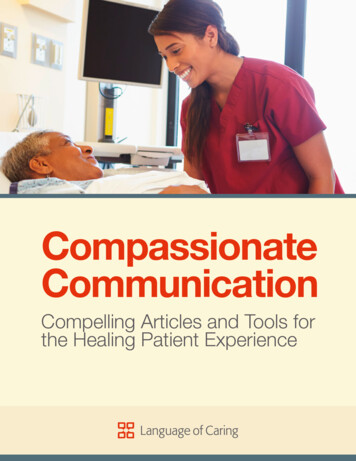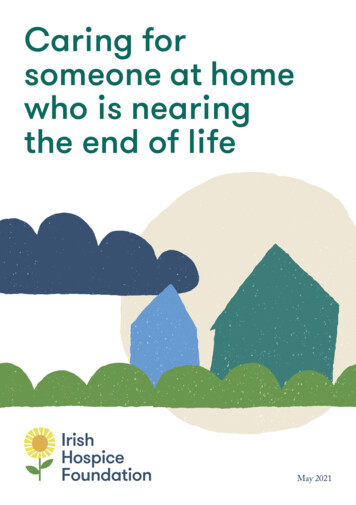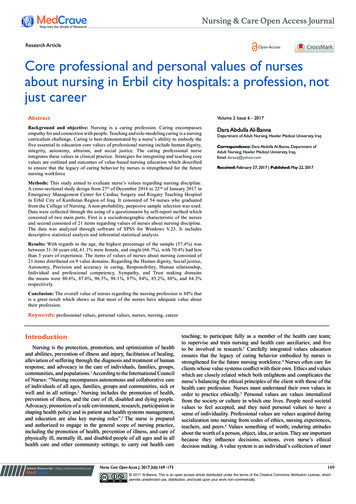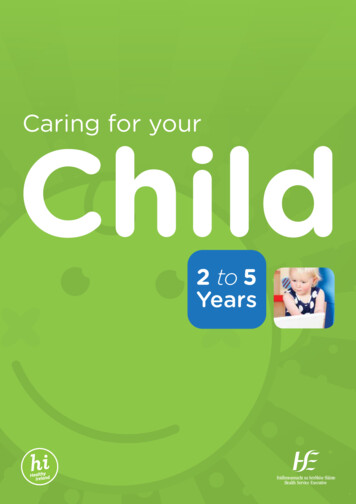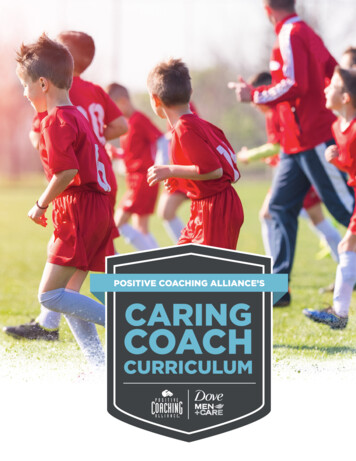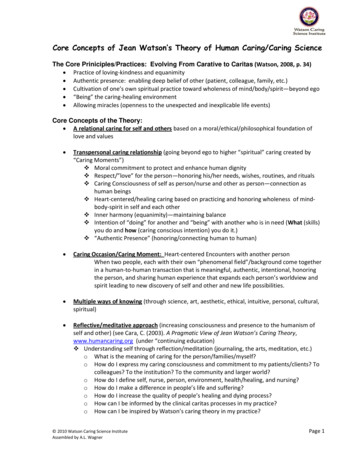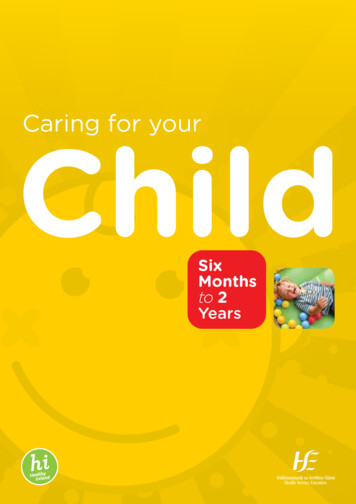
Transcription
ChildCaring for yourSixMonthsto 2Years
ContentsPageIntroduction31 Taking care of yourself as a parent 4Especially for Mams4Especially for Dads5For Mams and Dads6Getting extra support for parents7Caring for twins or more92 Feeding your young childSixMonthsto 2YearsYour Public Health Nurse:Your Health Centre:10Breastfeeding10Formula feeding11Starting to spoonfeed your child12A healthy, balanced diet for your child18PageWeight gain and growth41Your child’s eyes42Your child’s hearing43Your child’s speech and languagedevelopment44Your child’s social, emotional andbehavioural development46Health checks for your child53Your child with special needs546Playing and learning58What is play?58Common questions about food and children 19Learning through the senses60Caring for your child’s teeth20Developing through play613 Sleeping and crying24Playing with toys647 Keep your child safe66How to keep your child safe66Where should my child usually sleep?24How much sleep does my child need?25Reducing the risk of cot death26How can I keep my child safe in the sun? 67Why does my child cry?28What should I do if my child has anaccident?68How can I keep my child safe outsidethe home?68Travelling in the car with your child684 Caring for your young childevery day30Bathing your child30Dressing your child30Preparing to toilet train30Lifting and carrying your child31Immunisation32Common childhood illness34guide to your child’s growth5 Aand developmentPosture and development38388 Childcare arrangementsBabysitting arrangements9 Your benefits & leaveentitlements10 Useful web pages &phone numbers70707276
ForewordThis information pack is the second in a setof three packs for parents: Caring for Your Baby: Birth to Six Months Caring for Your Child: Six Months to Two Years Caring for Your Child: Two to Five YearsEach one contains information to help you to carefor yourself and your child during your child’s firstfive years. Before we produced this informationpack, we asked parents what information theyneeded to care for themselves and their baby ortoddler during this time. Parents said they wantedcommon-sense information and tips on the generalcare of their child; information about the growthand development of their child; advice about whatto do if their child has a problem; and details ofwhat people and services to get in touch withfor more help and support.IntroductionThe information in this pack is based on themost up-to-date, accurate information availablewithin the Health Services, and on opinion fromprofessionals in child health, support services,voluntary organisations and parent groups.Each baby is special and for some of you,the details in this pack are only the beginningof your search for information on how to dothe best for your baby and you. No booklet isa replacement for talking with someone who istrained to help you, so the useful web pages andphone numbers at the end of the pack will helpyou reach a wide range of trained professionals.Sincere thanks to all the health professionalswho helped in the development of this childhealth information pack, especially the parents.Welcome to Caring for Your Child: Six Months to 2 years.This booklet contains valuable information to help you care for yourself and your childover the next year and a half.Caring for your young child is an exciting and challenging time for everyone involved.This information pack will help you deal with the everyday concerns of being a parent.It will also point you to people and services that offer further information and support.We hope you enjoy reading it and find it useful.Baby ChildCaring for yourCaring for your2 to 5YearsFor copies, contact your Public Health Nurse or see www.hse.ie/caringforyourbabyFirst publishedOctober 2005Reviewed2009Updated20153
1 Takingcare of yourselfas a parentEspecially for MamsCaring for a small child is rewarding, but it can be very tiring too. Let your partner or a familymember help with the day-to-day housework, if you can. Then you can focus on your childand yourself until a pattern forms in your daily routine that you are able to manage. If you donot have a family member to turn to, see page 7 for details of extra support.You may also feel that you have very little time for yourself since your child was born. It isimportant to look after your own needs so that you are better able to look after the needs ofyour family. Here are some tips to help you unwind. Ask your partner or a family member to look after your child while you have a short rest Go for a walk or a swim Call in on a friend for a chat over coffee Treat yourself to little things such as a trip to the hairdresser if you can afford itTop Shelf foods are high in fat, sugarand salt, are not essential for healthand taken in excess can be harmful.Maximum 1Fats and oils are essential,but only in small amounts.Chooseany 2The foods and drinks on thebottom 4 shelves of theFood Pyramid are essentialfor good health.Chooseany 2Chooseany 3Chooseany 5 Eating wellIt can take your body up to nine months to recover fully after a pregnancy and delivery,especially if you had a caesarean section. To help you recover, follow a healthy eating planand combine it with exercise. Look at the food pyramid to help you choose a balanced diet.Remember going on a weight loss diet is not recommended just after you have given birthespecially, if you are breastfeeding.Read our leaflet ‘Your Guide to Healthy Eating using the Food Pyramid’ available in thepublications section on www.healthpromotion.ie4Chooseany 6 Especially for DadsAs your child grows and develops, he or she will become more alert. The most importantthing you can give your growing child is your love. This includes spending time with yourchild and getting to know them by keeping actively involved in their routine. If you workoutside the home, set aside some time when you come home. Play and read with your child,even though you may feel tired after a day’s work. Remember that your partner is also tiredafter a long day caring for your child or working, just like you. After you spend time withyour child, spend time with your partner to chat and relax. You also need to care for yourself.Arrange some free time for yourself to relax. For example, meet up with friends or go to the gym.5
As the months go by, your child settles into a pattern, including feeding and sleeping.Then your child begins teething at around 6-9 months old. Your sleepless nights maybe back again. If you feel all of this is getting to be too much, or if it’s affecting yourability to concentrate at work, then talk with your partner about ways you can bothmanage through this time.Sometimes, you may not have a partner to turn to for support. Talk to your doctor,the public health nurse or the Child and Family Agency and they may suggest waysyou may get extra help.For Mams and DadsPhysical activityExercise is an important part of both parents’ lives. It helps you to unwind and keeps youboth healthy and alert. Here are some tips for keeping active and healthy. Go for a walk with your partner. Take your child in their pram Go for a swim with your family Play in the park with your childCheck out the events section on www.getirelandactive.ie for sports in your area.Smoking and drinking alcoholIf you gave up smoking during the pregnancy you gave your baby a great start. Try to stayoff cigarettes as smoking around your baby can contribute to cot death. Help and support isavailable on www.quit.ie or talk to your doctor.If you stopped drinking alcohol during your pregnancy now may be a good time to look atyour drinking habits. Do you know your limits? Do you know what a standard drink is?Find out more at www.yourdrinking.ieGoing back to workIt can be stressful and exhausting if you are going back to work outside the home whenyour maternity or paternity leave is over. Juggling home, school, work and other routinescan be stressful. You may now have to send your child to a childminding service or have a childmindercome to your home You may also have older children to get ready for school You will have to focus on your job as well You may have to do all this when you might feel tired as a result of adjusting to yourchild’s sleeping, feeding and daily routines6But it is important to find the balance between your work needs, your family needs and yourown needs. As your child grows, a daily routine will emerge. Try to reduce the stress bypreparing for it by making packed lunches, and preparing older children’s sports bags aheadof time. Get up 10 minutes earlier to give your family some breathing space in the morning.Plan meals in advance. While it will not get any easier, you will get more used to the dailyorganising that is part of being a parent.Looking after yourself and your close relationshipsAs a parent, you aim to do the best for your child and your family. You learn to do this asyou go along, taking the tips you learned from your own upbringing, from other people andfrom the supports around you. Remember that you are also a person as well as a parent.You need to look after yourself so that you can look after others around you. Take care ofyourself and your close relationships in the ways listed below. Be realistic as a parent. Try not to expect too much of yourself or of others around you,but don’t take yourself or others for granted either Trust your instincts. You are doing a good job and learning new things every day in thisimportant role Reward yourself regularly by relaxing and doing something that makes you feel good,like taking some time out to go for a walk or go to the pictures or go out for a meal withyour partner or a friend If you make mistakes, then learn from the experience and move on. All parents makemistakes because nobody is perfect Although you may not always agree with your partner, never argue in front of your child.Arguing upsets children. Discuss your feelings in private and work out a solutiontogether If you find that it is hard to cope, then do not be afraid to ask for extra helpGetting extra support for parentsThere may be certain times as a parent when you need extra support to help your child andyour family. You are not alone in looking for help. You will find that other parents need extrasupport at times too. Getting extra support is a smart thing to do it clearly shows that youvalue your family. There is a wide range of services available to help you and your familywhen you need it. Here are some examples of supports;Public health nurses are there to help you and your family. They are experienced in thearea of child and family health and offer: Health promotion information and advice Support to parents and carers of children7
For example, your public health nurse can give advice on feeding including breastfeeding;on your child’s development, progress and wellbeing; and advice about children with specialneeds or long-term illness. Your public health nurse can also refer you to other sources ofsupport in your local area such as: A parent and baby or toddler group The community mothers’ programme Breastfeeding support groups Parenting classes Support services offered by the HSE and other organisationsLocal Psychology Services: Your doctor and other professionals can give youinformation on your local child, adolescent and family psychology service or make a referralfor you if necessary.These services are examples of what support is available to you. There are many otherservices, such as your family doctor and practice nurse. These services can also put youin touch with other sources of support that best suit you and your family.Caring for twins or moreThe Child and Family Agency is a resource for families and their well being. If you oryour partner are unhappy in your relationship, or if there is conflict and you argue in front ofyour children, seek professional advice. The Agency links with voluntary organisations aroundthe country that offer:Caring for twins or even more children at one time is a joyful experience for you and yourfamily. But the day-to-day reality also means more work and worry. There are also practicalexpenses to think of such as more space in your house or a bigger car to transport yourgrowing family. If you are lucky, you have family and friends to help with the day-to-day jobsand childcare needs. Marriage counsellingFor more detailed information and advice about services and supports in your area, contact: Child counselling The local public health nurse Child bereavement (sadness) counselling and support The pre-school officer Family mediation. Family mediation is a free and confidential service that helps parentswho have decided to separate or divorce. Mediation helps you look at and sort out thewide range of issues involved, such as future childcare or money issues A community welfare officer Your family doctor and practice nurse The community mothers programme The Irish Multiple Births Association. See www.imba.ie or call 01 874 9056The Child and Family Agency provides support to families through their Family ResourceCentres see www.tusla.ie or call 01 635 2854.Barnardos helps children and families who need extra support at times. Barnardos worksto develop a family’s ability to care for their children and build better prospects for the futurefor everyone. Their services include:Another issue for parents of twins or more is reminding your family and friends to treat all ofyour children as individuals and not as ‘the twins’ or ‘the triplets’. You can do this by: Calling each child by his or her own name and not calling them ‘the twins’ and so on Family support in partnership with the HSE Making eye contact and talking to each of your children separately Bereavement counselling for children Information, training and a range of leaflets and books for parents and people who workwith childrenMaking some special time with each child, for example by bringing one childwith you when you go shopping Encouraging each child’s uniqueness,for example in the way eachchild is dressedFor more information call 1850 222 300 or see www.barnardos.ieSocial work departments provide a wide range of preventative and child protectionservices. Social work services are for children and families who sometimes need extrasupport to cope and do their best for their family. Social workers work closely with parentsand children to find out what their needs are and to develop a plan to meet those needs.Contact details for social workers are on www.tusla.ie or call 01 635 2854.89
2 eeding your YoungFChildThis useful booklet has guidelines on:BreastfeedingWe talked about breastfeeding in the booklet Caring for your Baby: Birth to Six Months Old.The information included: Tips on breastfeeding The importance of breastfeeding for your child and yourselfIf you don’t have the first information pack, ask your Public Health Nurseor see www.hse.ie/caringforyourbabyYour breastmilk continues to provide an important part of your baby’s diet as heor she grows. From 6 months you can start your baby on solid foods and continueto breastfeed to 2 years or older.Breastfeeding groups are helpful places to go to meet other mothers. Your public healthnurse can give you the details of your nearest group or log on to www.breastfeeding.ie.These groups are run by public health nurses or mothers who are trained to supportbreastfeeding.How can I breastfeed outside the home?You can continue to breastfeed your child for as long as you and your child feel happyto do so. You can do this by combining breastfeeding with a healthy balanced diet of solidsfor your child. When out and about remember you don’t have to ask tobreastfeed, you can breastfeed anywhere you and your baby want orneed to. Breastfeeding is the normal and natural way to feed yourbaby and you should feel proud and confident in your decision tobreastfeed. The Equal Status Act (2000) protects mums frombeing discriminated against or harassed because they arebreastfeeding in a public area. For more information seewww.healthpromotion.ie/breastfeedingFor tips about breastfeeding when you return to work, read ourleaflet ‘Breastfeeding and Work’ available in the publicationssection of www.healthpromotion.ie10 How to mix breastfeeding and workEntitlements and tips to help you continue to breastfeed your childHow do I wean my child from the breast?You can wean your child when it suits both your child and you. Many children will self wean.If you chose to wean before this, weaning from your breast should take place slowly. Stopone breastfeed every 2-3 days for the first few weeks. During the times you do not offeryour child breast milk, give them a feed from a cup or bottle. If you stop breastfeedingbefore your child is 1 year old, you will need to give them formula feeds. After your child gets used to this new routine, stop another of the daily breastfeeds.Keep doing this until your supply of breast milk has stopped completely If your breasts feel hard and uncomfortable at any stage, try hand expressing a little milk,just enough so you feel comfortable If you are concerned about weaning your child, or about your own supply of milk,talk to your public health nurse, doctor, practice nurse or local community breastfeedingsupport groupFormula feedingHow long do I continue to give my child formulafeeds?You need to give formula feeds to your child until your child is 1 year old. This is becausecow’s milk is too concentrated in protein for young children. After one year, change toordinary cow’s milk.Do I give my child ‘follow on’ formula milk?Follow on formula milk is not necessary. By the age of 1 year, your child should have awell-balanced diet, including foods that are rich in iron. Iron is important for your child’sdevelopment.Ask your midwife, public health nurse, doctor, practice nurse, community dietitian or localchemist for more advice on formula feeding your child.11
Starting to spoonfeed your childWhen do I start my child on solid foods(spoonfeeds)?The introduction of solid food to baby’s diet should take place at about 6 months’ of age.The recommendations for age of weaning are the same for both breastfed and formula fedbabies. The exact timing to begin this process should be driven by the unique needs of thebaby. Your baby should not be introduced to solid food before 4 months (17 weeks) and thestart of weaning should not be delayed past 6 months (26 weeks) of age.Stages of WeaningFood texturesappropriate duringeach stage of weaningSkills learned througheach stage of weaningStage 1First foods should be thinpurées sieved or liquidisedto a soft runnyconsistency which willincrease in thickness asthe infant grows. Somesuitable Stage 1 weaningfoods are on page 14. Taking foods froma spoon Moving food from thefront to the back of themouth for swallowing Managing increasinglythicker puréesMove from thick puréesto mashed foods to foodswith soft lumps, and finallyto soft finger foods.Infants should also startdrinking from a cup. Somesuitable Stage 2 weaningfoods are on page 14. Moving lumps aroundthe mouth Chewing lumps Self-feeding bite-sizedpieces food using handsand fingersMove to minced andchopped family foods.More textured finger foodsshould be offered. Chewing minced andchopped foods Self-feeding bite-sizedpieces of food usinghands and fingers Learning to eat witha spoon Drinking fluids froma cupFrom about 6 monthsof ageSigns that your baby is ready for solid food Does not seem satisfied after a milk feedStage 2 Starts to demand feeds more frequently over a time period of more than one weekShows an interest in food, or may be reaching out for foodWatches others with interest when they are eatingChews and dribbles more frequentlyIs able to sit up with support and can control their head movementsBetween about 6-9months of age What foods are suitable to give mychild?The stages of weaningThe weaning process takes place in three stages,starting with the first spoon feeds when theinfant is 4 – 6 months old and finishingat 12 months.12Stage 3Between about 9-12months of ageA non-lidded beaker shouldbe used for all drinks otherthan breastfeeds.If an infant is being formulafed they should no longeruse a bottle by age 12months. Some suitableStage 3 weaning foodsare on page 15.13
Suggestions for Stage 1 foodsSuitable snack foods during stage 3 of weaningGluten-free cereal e.g. baby rice Vegetables made into purée e.g. carrot, parsnip, turnip, broccoli, cauliflower, butternutsquash, courgette. Purée means to sieve, blend or liquidise food to a soft, runnyconsistency. Purée food because your child is learning to chew instead of to suck. Breads Fruitmade into a purée, e.g. banana, stewed apple, pear, peaches, apricots,plums, melon Meat,poultry and fish purées, e.g. red meat such as lamb and beef Onefinger of cheese or bread toasted 3-4well cooked pasta shapes. E.g. bow-ties, shells Onepiece of chapati Smallpiece of a bread stick with cheese spread or hummus Smallpiece of naan bread or pitta bread with smooth peanut butter* 1-2Suggestions for Stage 2 foodsCereals, potatoes, pasta and rice & pastaunsalted crackers Smallportion of a plain scone 1 plainrice cake 1 smallpancakeMashed potato, pasta, rice, bread* Smooth peanut butter spread can be included in the diet of infants who have not been diagnosed witha peanut allergy and are more than 6 months of age.Meat, poultry, fish, eggs and beansStewed/baked/steamed/boiled/grilled fish (remove bones), beef, mutton, lamb or pork Tinned fish – watch out for bones and mash well Minced meat and chicken Peas, beans and lentils Fruits & vegetables Fruitslices e.g. melon, banana, pear, apple, mango, orange, satsuma Chopped fruit, e.g. halved and deseeded grapes Diced soft pieces of fruit, e.g. apricotsMilk, yogurt and cheese Soft cooked chunks of vegetables, e.g. carrot, parsnip, swede, sweet potatoFull-fat pasturised soft cheese, e.g. cottage cheese, cheddar (grated), ricotta YogurtYogurt, milk and cheese SmallFruit and vegetable pot of plain natural yoghurt with some chopped/ sliced fruit Cube/Fruits, mashed or given as small and softbite-size pieces when the infant is readye.g. soft apple, pear, plum, banana etc.triangle/ slice of firm cheese, e.g. cheddar cheeseMeat, poultry, fish, eggs and beansMashed or cooked slices of vegetablese.g. carrot, turnip, parsnip, broccoli,peas etc. Stripsof freshly cooked meat or chicken Eggs- scrambled, boiled or poachedAt this stage the more foods the child is exposed to, the greater likelihood that the child willbe eating a variety of nutritious foods when they are older.1415
From 1 year on, give your child a beaker of milk at the three main meals a day. This is600mls (1 pint) of milk a day in total. Drinking more than this can reduce your child’sappetite for solids.Purée means to sieve, blend or liquidise food to a soft, runny consistency. Purée foodbecause your child is learning to chew instead of to suck.Chewing helps the development of jaw and tongue muscles that your child will use later forspeech. Most children need snacks between main meals. These snacks can include yogurt, fruitor bread Do not add salt or sugar to your child’s foodNever leave your child alone while they are eating in case they chokeDo not give nuts to children under five. Nuts might cause chokingDo not give low fat milk to children under 2 years oldDo not give skimmed milk to children under 5 years old For more information on feeding your child see ‘Feeding your baby: introducing familymeals’ in the publications section of www.healthpromotion.ieWhat liquid can I use to soften andprepare my child’s solid food?Breast milk or formula milk Water or stock from cooked vegetables Cooled boiled water Cow’s milkTo prevent your child from choking on food, cut the food into small bites Homemade meals are often cheaper, more nutritious and tastier than jars of boughtbaby food You can also spoonfeed your child using foods that are more traditional to your culture Encourageyour child to sit at the table or to sit still while eating. Children can choke onfood if they are walking or running around while eatingAlways wash your hands before you prepare food.From 6 months old, what drinks can I give my baby?Cows milk should not be offered as the main milk drink until your child is 1 year old (or laterfor a premature baby). Small amounts of pasteurised full fat cows’ milk can be used toprepare weaning foods from 6 months onwards. Breast milk should be used as the main drink for the first year of life. If breast milk isnot available, standard infant formula should be used Cooled boiled water can be offered as extra fluid. Give your child cooled, boiled waterin a cup at mealtimes or at snack timesFrom 6 months old what drinks are unsuitable formy child? Gravy Stock cubes Jars or packets of sauce, as these contain a lot of salt DoHow should I spoon feed my child? juices are not needed. Try to give cooled boiled water only until your child is 1 yearold. If you choose to offer juices, only small amounts of well-diluted, unsweetened fruitjuice (dilute 1 measure pure fruit juice to 8-10 measures cooled boiled water) should begiven from a beaker only at mealtimes or with snacks and only from 1 year onwards.Do not use: Organise meal times so that your child eats with your family whenever possible FruitUse: Use a high chair with a suitable harness to strap in your child, or sit your child facing youon your lap and hold them securely with one hand while you spoonfeed them with yourother handGive the solid food first. Then give milk16not give your child tea or coffee. They make it difficult for iron to be absorbed andcontain caffeine Do not give fizzy drinks to your child, as they have a lot of sugar and acid, which isharmful to teeth. Fizzy drinks also fill up your child’s little tummy so they may not wish toeat their meals Do not use bottled water to make up your child’s drinks. Bottled water has large amountsof some salts that can be harmful to your child. If your tap water is not suitable fordrinking even after boiling, you can use bottled water that contains less than 20 mg ofsodium (salt) per litre17
When can my child start drinking from a beaker? From 6 months, your baby can start drinking from a beaker Fluids other than breastmilk can be offered from a lidded beaker with a non-valved,free-flowing spout Aim that by 12 months of age, a non-lidded beaker will be used for all drinks otherthan breastfeedsA healthy, balanced diet for your childWhy is iron important for small children?Your child is growing rapidly. Iron is important in your child’s diet to maintain healthy bloodand normal growth and development. For instance, iron helps make new red blood cells thatcarry oxygen from your child’s lungs to their body. Most babies are born with stores of ironthat last about six months. After this, your growing child needs to get iron from the foodsthat he or she eats.What happens if my child does not get enoughiron?Your child may develop anaemia if he or she does not get enough iron in their diet. Anaemiais a lack of iron in the blood. Recent studies found that half of Irish 2 year-olds have lowlevels of iron, with almost 10% suffering from anaemia because of this. If your child hasanaemia, they might seem: Tired and pale with a poor appetite Less able to fight infectionMeat such as beef, lamb, pork, poultry Eggs(well-cooked), peas, beans, lentils, green leafy vegetables e.g. spinach, broccoli.Eating foods rich in vitamin C at the same time improves iron absorption. Fresh fruit andvegetables are good sources of vitamin C What are fussy, faddy and picky eating habits?Fussy, faddy and picky eating is a phase when your child doesn’t eat well or refuses to eatcertain foods. Children’s appetites differ greatly. Don’t be upset if they refuse to eat well onany one day. This is a part of growing up, but it can be very worrying for you as a parent.If this fussy eating continues, ask for advice from your public health nurse, doctor, practicenurse, or pharmacist.What can cause fussy eating?Your child may be: Unwell now or in the recent past Eating too many sugary snacks between mealsDrinking too much milk or other drinks Showing their independent streak! What can I do to encourage mychild to eat well?Offer a wide variety of foods and include your child’s favourite foods regularly Put small portions on a plate, as a large amount of food can be very off-putting Let your child eat their food first at mealtime. Then give them the drink at the endof the meal Give your child enough time to eat Your child watches what you do, so sit down as a family at mealtimes to eat Involve your child in preparing and cooking the food by telling them what you are doing If your child still refuses to eat, calmly take the food away after 10 minutes. They areunlikely to starve, but if you create a fuss, mealtimes can become a battleground.What are the best sources of iron? Common questions about food andchildrenLiver is not recommended as it contains too much vitamin ARed meat is the best source of iron. Give it to your child 3-4 timesa week.18Do not force your child to eat, but be firm and praise your child when they do eat Do not use food or sweets as a reward or a punishment Tummy BugsTummy bugs are common in babies and young children. If they have a tummy bug, givethem an oral rehydration solution such as dioralyte. It’s available from the pharmacy and isa sachet of powder which you add water to. Give this drink freely to your child, as well astheir normal milk feed, which should be continued and never stopped. Never give your childwho has a tummy bug boiled or flat fizzy drinks19
What is constipation?Constipation is a hard bowel motion. Normal bowel motions should be bulky and soft. Forsome children, normal means passing a bowel motion once a day or every second day. Yourchild may be constipated if they:Are unable to empty their bowel fully when they go to
Welcome to Caring for Your Child: Six Months to 2 years. This booklet contains valuable information to help you care for yourself and your child over the next year and a half. Caring for your young child is an exciting and challenging time for everyone involved. This information pack will help you deal with the everyday concerns of being a parent.

